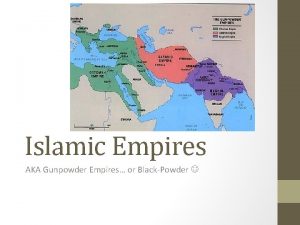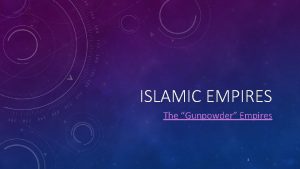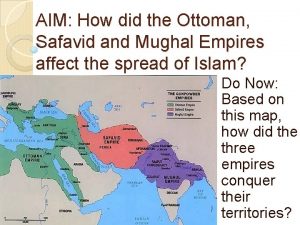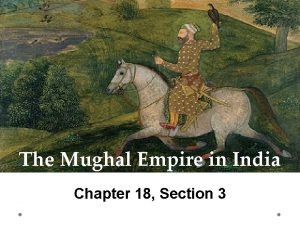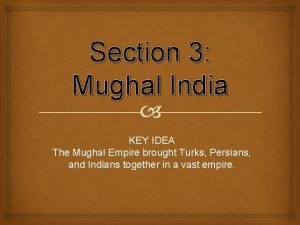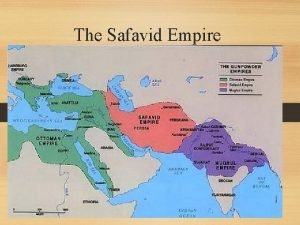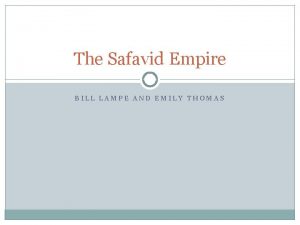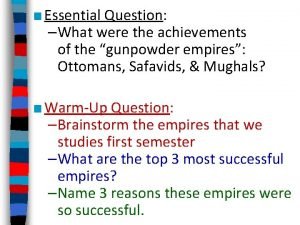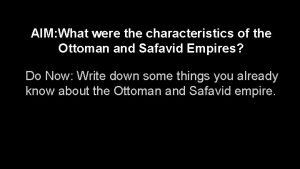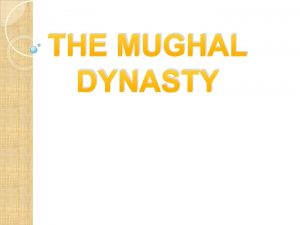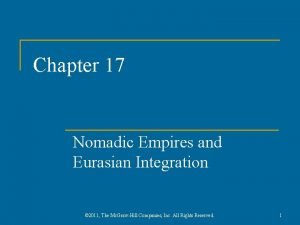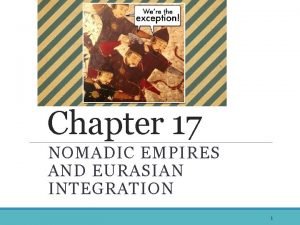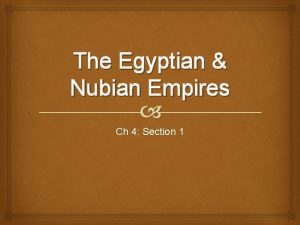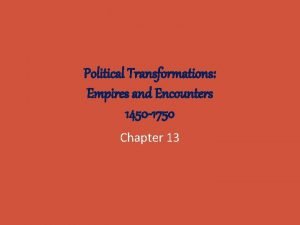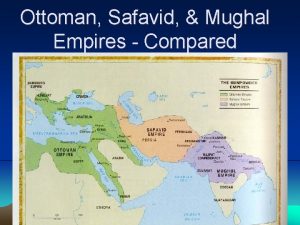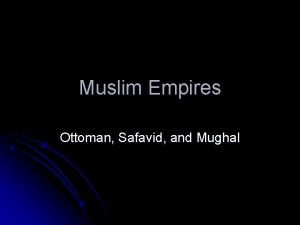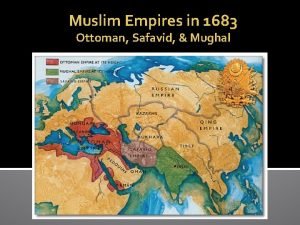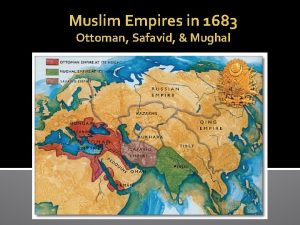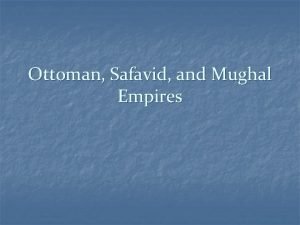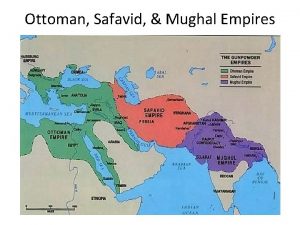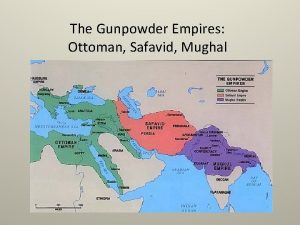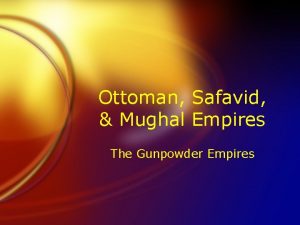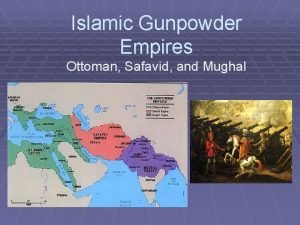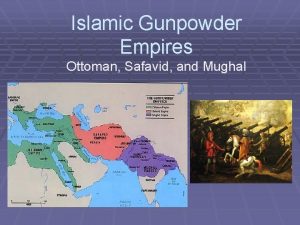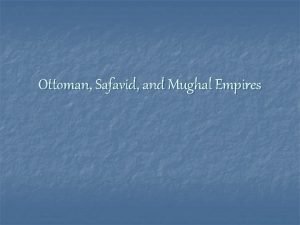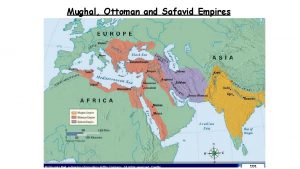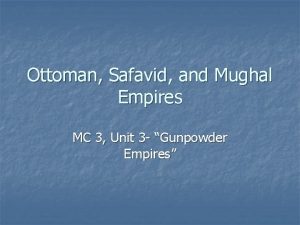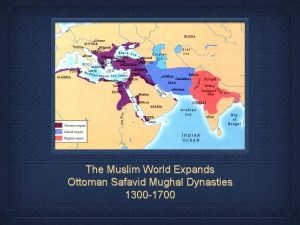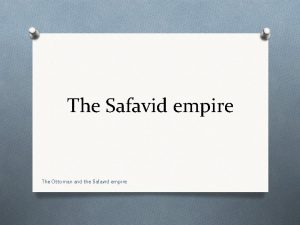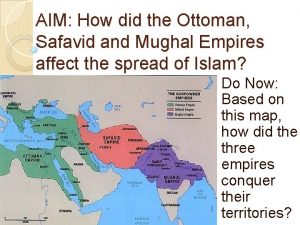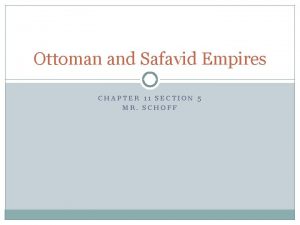CHAPTER 21 MUSLIM EMPIRES Ottoman Safavid and Mughal




















- Slides: 20

CHAPTER 21: MUSLIM EMPIRES Ottoman, Safavid and Mughal dynasties


“Gunpowder empires” similarities Islamic Centralized government Sultan - Ottoman Shah - Safavid Emperor - Mughal Bureaucracies managed the empires (Ottoman bureaucracy was the most extensive)

They existed at around the same time – Suleiman (Ottoman), Abbas I (Safavid), Akbar (Mughal) were the rulers at the height of each empire and were contemporaries. Warrior aristocrats were awarded land peasants for support of leader


Weapons: cannons and muskets were the key for these empires’ successes

Each had slavery as an institution non-Muslims were slaves the status of slaves varied widely Concubines of India

Leaders patronized the arts Example: Architecture huge focus of these leaders’ energies incorporated Islamic elements Istanbul: Sulimaniye mosque

Dehli: Red Fort

Taj Mahal


Safavid: Shah Mosque (note the blue tiles)

Religious tolerance Government positions were available to outsiders and non. Muslims Ottoman empire Janissaries Devshirme Russian army slave boys in the Safavid dynasty

Dhimmi Millets Overall, the Ottoman empire was more religiously tolerant than other early modern societies

Religious intolerance Religious minorities were persecuted at times e. g. Sikhs in Mughal empire Non-Muslims paid higher taxes Missionary efforts and reforms aimed at religious nonconformists

Differences and conflicts The split between Sunni and Shi’a traditions of Islam intensified Safavid Day used Shiism to legitimize their rule of Ashura: http: //www. washingtonpost. com/world/shiite- muslims-mark-day-ofashura/2011/12/05/g. IQAa 8 PTWO_gallery. html#photo=1 Ottoman Sunnis frequently conflicted with Shi’a Safavids

Dark green: Shi’a populations today

Similar factors leading to decline Stretched too thin Succession issues Corrupt and/or inept leaders Taxation and poor treatment of peasants revolts and rebellions

LAND BASED EMPIRES VS. SEA BASED EMPIRES

Land Based Sea Based Self-defense extremely important Few strategic concerns Examples? Ottoman, Russian, Mughal, Ming Spain, Portugal, England Relatively Large Relatively Small Expensive Self-sufficient Settled in in profitable areas Involved in forced labor Power “divided” amongst lands Focused on agriculture and not industry Many were located in arid & uninhabitable areas Involved in forced labor Power was centralized Largest administrative and economic systems from 1500 and 1800, because they were more of a threat to each other Benefited from private investors or joint-stock companies
 How did the ottoman safavid and mughal empires arise
How did the ottoman safavid and mughal empires arise Ottoman, safavid, and mughal empires venn diagram
Ottoman, safavid, and mughal empires venn diagram Ottoman safavid and mughal empire map
Ottoman safavid and mughal empire map Ottoman safavid and mughal empire map
Ottoman safavid and mughal empire map Ottoman safavid and mughal empire map
Ottoman safavid and mughal empire map What was the safavid mughal conflict
What was the safavid mughal conflict Maritime and land based empires differences
Maritime and land based empires differences Chapter 18 section 3 the mughal empire in india
Chapter 18 section 3 the mughal empire in india The mughal empire in india chapter 18 section 3
The mughal empire in india chapter 18 section 3 Safavid empire
Safavid empire Bruno cameron
Bruno cameron Where is the safavid empire located
Where is the safavid empire located Safavid religon
Safavid religon Achievements of the safavid empire
Achievements of the safavid empire Safavid empire achievements
Safavid empire achievements Safavid empire characteristics
Safavid empire characteristics Who was babur
Who was babur Chapter 17 nomadic empires and eurasian integration
Chapter 17 nomadic empires and eurasian integration Nomadic empires and eurasian integration
Nomadic empires and eurasian integration Chapter 4 section 1 the egyptian and nubian empires
Chapter 4 section 1 the egyptian and nubian empires Chapter 5 political transformations empires and encounters
Chapter 5 political transformations empires and encounters
